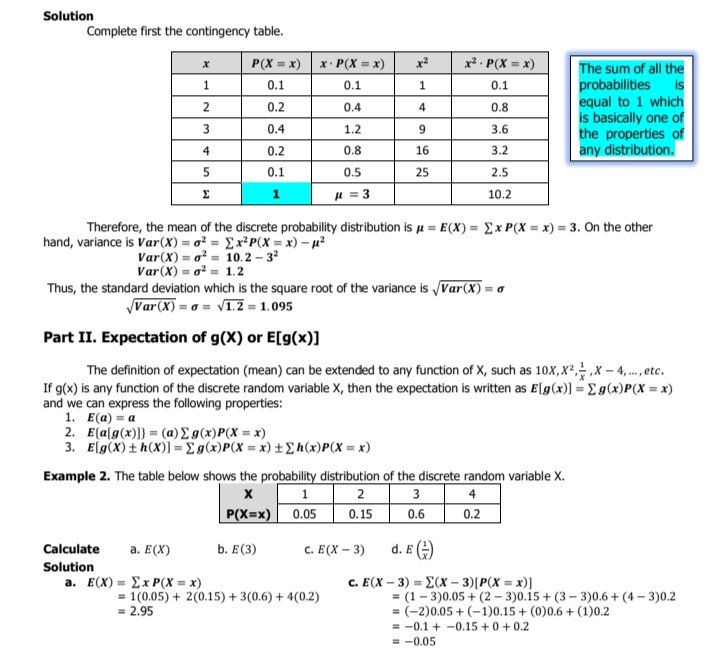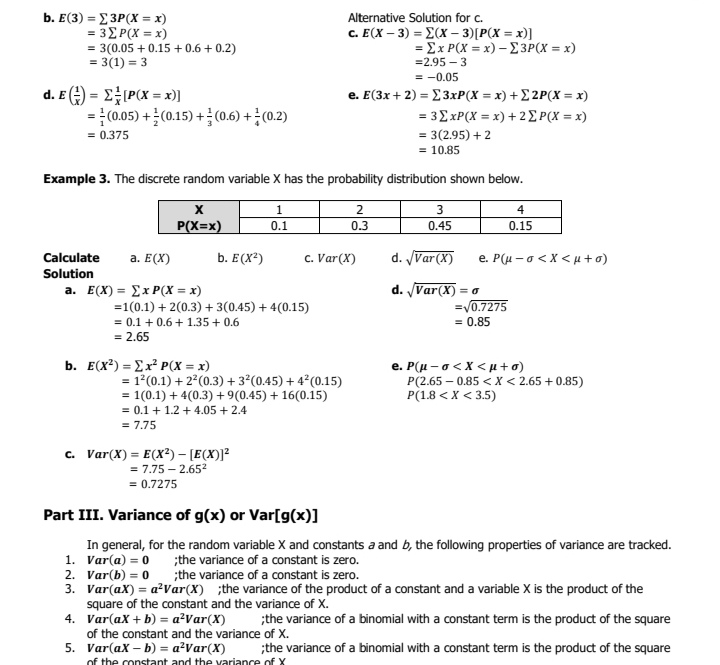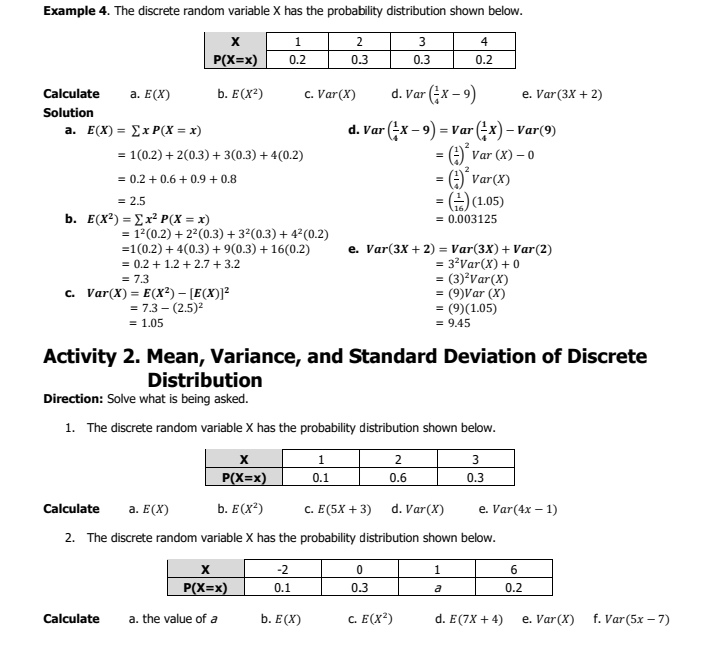Statistics and Probability Module Title: Mean, Variance, and Standard Deviation of Discrete Distribution Activity Number: 2 Objectives: computes probabilities corresponding to a given random variable. illustrates the mean and variance of a discrete random variable. calculates the mean and the variance of a discrete random variable. interprets the mean and the variance of a discrete random variable. solves problems involving mean and variance of probability distributions. Terminologies Random Variable refers to a function that maps outcomes of a random experiment to a real number. It is denoted by X and its value as x. Mean or Expected Value of Discrete Distribution refers to the result you would expect if you took a very large number of values of X and found their mean. It is written as E(X) and denoted by the Greek letter H. Formula E(X) = H = Ex P(X = x) Mean is equal to the sum if the product of x and its respective probability. Variance of Discrete Distribution refers to the square of the standard deviation. It is written as Var(X) and denoted by oz. Formula Var(X) = 03 = E(X-) - p' Var (X) = 0' = E[(X - #)- Var (X) = = >(x -") . P(X = x) Var(X) = 0' = Ex-P(X = x) - - Var (X) = = E(X') - [E(X)] Variance is equal to the product of the sum of square deviation and its respective probability. Standard Deviation Discrete Distribution refers to the measure of spread of X about the mean . It is written as ,Var (X) and denoted by the Greek letter a. Formula Var (X) = a Standard deviation is equal to the square root of the product of the sum of square deviation and its respective probability. Lesson Proper/ Examples Part I. Mean, Variance, and Standard Deviation of Discrete Distribution Example 1. The discrete random variable X has the probability distribution shown in the table below. Find the mean, variance, and standard deviation. X 1 2 3 4 5 P(X=X) 0.1 0.2 0.4 0.2 0.1Solution Complete first the contingency table. P(X = x) x . P(X = x) x2 . P(X = x) The sum of all the 0.1 0.1 1 0.1 probabilities is 2 0.2 0.4 4 0.8 equal to 1 which is basically one of 3 0.4 1.2 3.6 the properties of 4 0.2 0.8 16 3.2 any distribution. 5 0.1 0.5 25 2.5 1 # = 3 10.2 Therefore, the mean of the discrete probability distribution is # = E(X) = Ex P(X = x) = 3. On the other hand, variance is Var(X) = a' = Ex-P(X = x) - #' Var(X) = = 10.2-32 Var (X) = = = 1.2 Thus, the standard deviation which is the square root of the variance is ,Var (X) = a Var (X) = = v1.2 = 1.095 Part II. Expectation of g(X) or Elg(x)] The definition of expectation (mean) can be extended to any function of X, such as 10X, X?,= , X - 4,., etc. If g(x) is any function of the discrete random variable X, then the expectation is written as Elg(x)] = Eg(x)P(X = x) and we can express the following properties: 1. E(a) = a 2. Etalg(x)]) = (a) Eg(x)P(X = x) 3. Elg(X) + h(X)] = Eg(x)P(X = x) + Eh(x)P(X = x) Example 2. The table below shows the probability distribution of the discrete random variable X. X 2 3 4 P(X=x) 0.05 0.15 0.6 0.2 Calculate a. E(X) b. E(3) C. E(X - 3) d. E () Solution a. E(X) = ExP(X = x) c. E(X - 3) = E(X - 3) [P(X = x)] = 1(0.05) + 2(0.15) + 3(0.6) + 4(0.2) = (1 - 3)0.05 + (2 - 3)0.15 + (3 - 3)0.6 + (4 -3)0.2 = 2.95 = (-2)0.05 + (-1)0.15 + (0)0.6 + (1)0.2 = -0.1 + -0.15 + 0 + 0.2 = -0.05b. E(3) = _ 3P(X = x) Alternative Solution for c. = 3 2P(X = x) C. E(X - 3) = E(X - 3) [P(X = x)] = 3(0.05 + 0.15 + 0.6 + 0.2) = Ex P(X = x) - E3P(X = x) = 3(1) = 3 =2.95 - 3 = -0.05 d. E H) = EX[P(X = x)] e. E(3x + 2) = E3xP(X = x) + _2P(X = x) = (0.05) + +(0.15) + =(0.6) + (0.2) = 3EXP(X = x) + 2EP(X = x) = 0.375 = 3(2.95) + 2 = 10.85 Example 3. The discrete random variable X has the probability distribution shown below. X 1 2 3 4 P(X=x) 0.1 0.3 0.45 0.15 Calculate a. E(X) b. E (X2) c. Var(X) d. Var (X) e. P( u- 0










